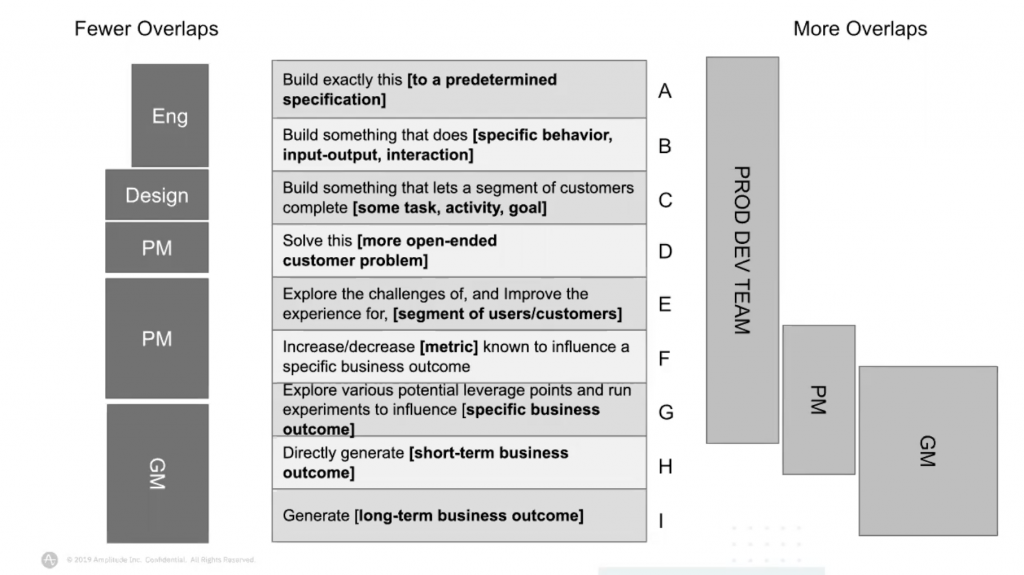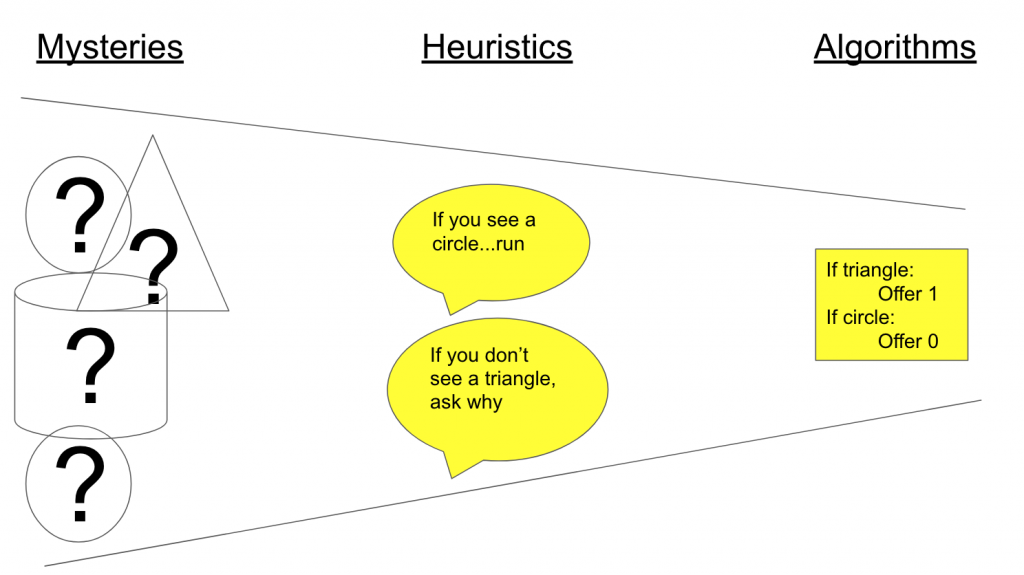Mandate levels, group choice, and organization
The diagram below, something that John Cutler put together, made me think. I got a kick out of it. Maybe you will too.

First, I’ll unpack the image. Second, I’ll contribute a few thoughts.
What are you looking at?
If you look down the centre, you’ll see nine instructions, called mandate levels, labelled from A to I. At level A you’ll find the instruction “Build exactly this [to a predetermined specification]”, at F, “Increase/decrease [metric] known to influence a specific business outcome”, and at I, “Generate [long-term business outcome]”.
To the left, you’ll see a few boxes, labelled Eng, Design, PM, and GM. To the right, similar boxes labelled PROD DEV TEAM, PM, GM.
The organization on the left is labelled “Fewer Overlaps”, as in there are few overlaps between Engineering, Design, Product Management and General Management. The organization on the right is labelled “More Overlaps” and features overlaps between the Product Development Team, Product Management, and General Management.
Why Is It Interesting?
There is so much to think about and play with here.
The mandate levels are sorted. There are a few ways to interpret the order. From most prescriptive to least. From fewest opportunities for creativity to least. From greatest information density to least. From least autonomy to most. There are many more interpretations.
It’s interesting to think about what the team experiences and how it performs as a result of a designated, assigned, or imagined, mandate level. Take, for instance, the experience of an engineering team that has been prescribed a very narrow mandate at level A. There may be many reasons why such a strange situation evolved. Perhaps a team demonstrated some initiative, only to have been smacked down, and so they’re resorting to hyper-specification as a form of malicious compliance. Perhaps a team has always been micromanaged because it operates in a very high risk, very highly regulated environment. Perhaps, a team is composed of so many juniors that literally everything needs to be defined and specified. Maybe, more often than not, many builds are extremely routinized and there is relatively few opportunities for improvement. There may be many other reasons.
Their performance and own sense of accomplishment not only becomes a function of the quality of the specification provided, but also the underlying complexity of the physics they’re experiencing, and how they experience the freedom they have to make it better. What they choose to be salient and what they kick out from consideration. What they choose to be thinkable and what is unthinkable. What they choose to be dogma and what is heresy. How group choice manifests itself as a function both of the soft carbon of the team itself from the inside and the hard constraints imposed upon it from the outside by the mandate level. Perhaps there is a reinforcing loop there.
The same can go with the Ith mandate level. The more heterogenous the executive team, the richer the quality of the discussion about what is a valuable outcome is, and, what is the definition of long term is. The safer the team, the longer the initial discussions and the better the quality of the planning. There’s a lot more ambiguity to navigate, and so, there’s a lot more preparation of the mind that is involved in the planning. Perhaps such teams would value abstraction and connectivity. Perhaps not.
Then it becomes very interesting to think about the internal life of teams overlap with others. How do teams come together across very different mandate levels to collaborate, to learn, and to inspire each other? Or do they fight each other for what little autonomy they have left? Does the leadership foster a high sense of security and mission that enables the valuable kind of friction and discussion that adds value? Or does leadership, out of fear and insecurity, hang onto it, deliberately setting up clashes so they can hero the situation to resolution? Are there rituals in place to be able to understand how much heat there is at some points?
How does information about the tradeoffs and choices within each mandate level manifest themselves? How are feedback loops embedded into the mandate levels? How does the population get smarter as a result of the information flow?
On this specific point, I’m reminded of all the stories of technical co-founders engaging with designers at startups for the first time. You may have heard of these stories where the founder gives a very high mandate level to a designer. Two weeks later, at 100% completion of a given templates redesign, the founder just wants to change one little thing. Can you make it pop. Can you change that button to blue. Can you make it so it doesn’t have a footer. It’s a breaking change and the whole design system falls apart. The design teams engagement suffers. The designer leaves the company voluntarily – if the founder is lucky. It’s an old story. Perhaps a better way would be to ritualize feedback, at 10%, 68%, and 90% completion points? Maybe there are different ways of learning?
Why should any of this matter?
It matters because this is the way that value is created by technologists in product organizations.
There is a tremendous amount of value creation in scaling execution at mandate level A. Consider McDonald’s. There’s a very specific way to build a hamburger. It’s entirely standardized. It certainly scales.
Vast parts of our economy feature people and machines executing at mandate level A. This is the exploitation phase of the knowledge funnel. And all of that value gets realized because somebody worked the knowledge funnel – from Mystery to Heuristic, and ultimately down to Algorithm.

In software development, machine intelligence, and data science, we often operate further up the knowledge funnel – where there are mysteries to be uncovered and heuristics to refine or challenge. We do it because there is the belief in new value creation. Value springs from the unknown. Ultimate sustainable competitive advantage derives from knowing and incorporating new knowing into exploitation.
The value in this context is the discovery of new knowledge. This is the work of technological development. How we organize our teams and organizations is an important predictor of that rate of learning and the with the promise of exploitation cycles in the future. It matters tremendously.
And it’s tremendously hard to sustain. The Lock-In that is produced by the familiarity of present knowledge is insidious because if you don’t know what to look for, you can’t see it. And there are tremendous advantages in sticking with known-knowns than there is to venture into unknown-unknowns. The very security that one seeks by emphasizing the way it has always been done is undermined by the behaviour.
Mandate levels offer a piece to the puzzle of how to realize a way out. It offers a way to manage the insecurity and risk of engaging with different parts of the knowledge funnel. And it’s for that reason that I’m thankful for just how many mandate levels John Cutler imagined for us.
I’m thanking John Cutler for presenting this puzzle piece.
I got a kick out of it, and I hope you did too.
